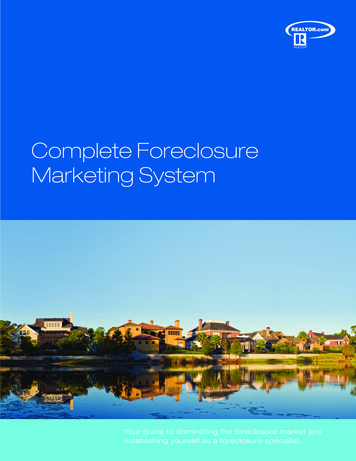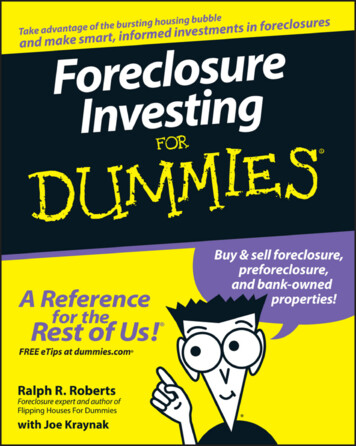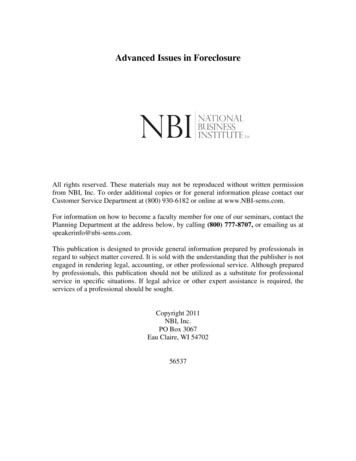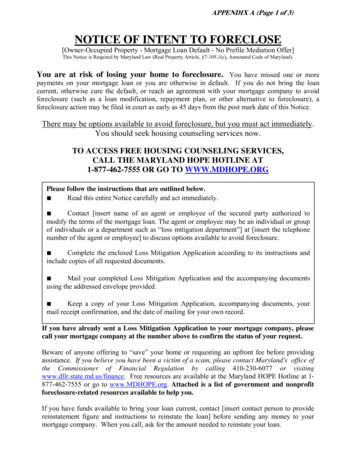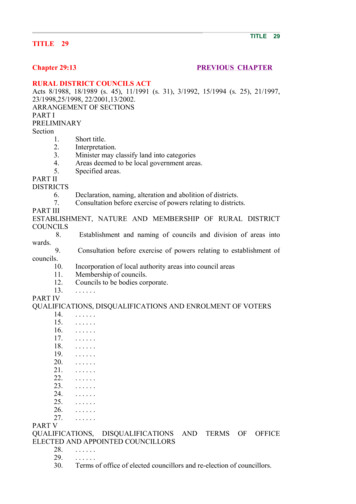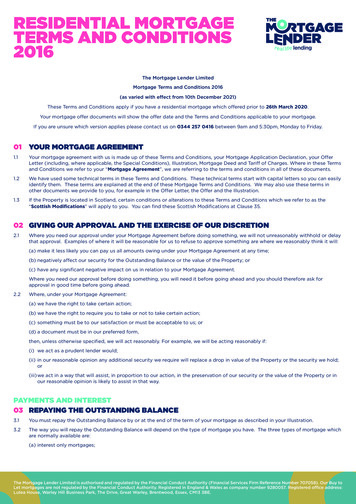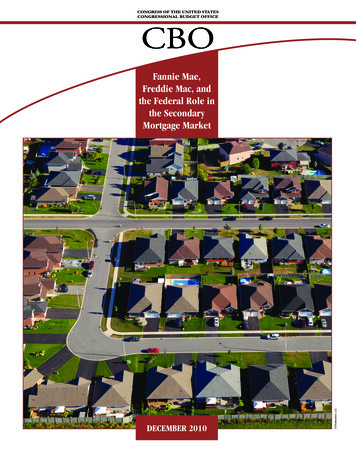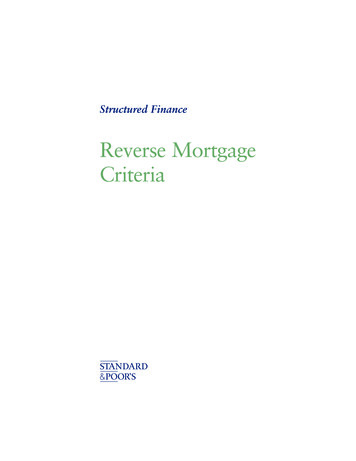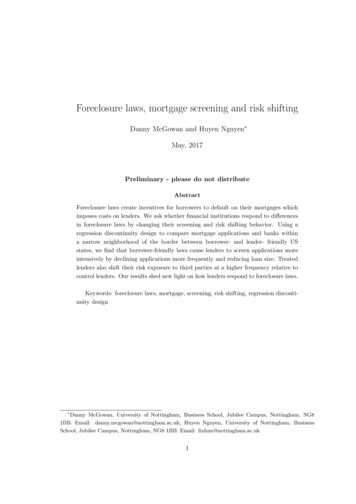
Transcription
Foreclosure laws, mortgage screening and risk shiftingDanny McGowan and Huyen Nguyen May, 2017Preliminary - please do not distributeAbstractForeclosure laws create incentives for borrowers to default on their mortgages whichimposes costs on lenders. We ask whether financial institutions respond to differencesin foreclosure laws by changing their screening and risk shifting behavior. Using aregression discontinuity design to compare mortgage applications and banks withina narrow neighborhood of the border between borrower- and lender- friendly USstates, we find that borrower-friendly laws cause lenders to screen applications moreintensively by declining applications more frequently and reducing loan size. Treatedlenders also shift their risk exposure to third parties at a higher frequency relative tocontrol lenders. Our results shed new light on how lenders respond to foreclosure laws.Keywords: foreclosure laws, mortgage, screening, risk shifting, regression discontinuity design Danny McGowan, University of Nottingham, Business School, Jubilee Campus, Nottingham, NG81BB. Email: danny.mcgowan@nottingham.ac.uk; Huyen Nguyen, University of Nottingham, BusinessSchool, Jubilee Campus, Nottingham, NG8 1BB. Email: lixhnn@nottingham.ac.uk1
1IntroductionThe recent subprime crisis in the U.S. was characterized by a shockingly high mortgagedefault rate. From a stable level of 1 to 3 percent between 2000 and 2005, the aggregatedefault rate on mortgages skyrocketed to 10 percent in 2009. This annual figure translatesinto more than 3,700 foreclosures every working day (Rao and Walsh, 2009). Observingthese adverse consequences, policy makers once again revisited the debate about foreclosure laws in the hope to improve the legal system to better protect homeowners. In 2014,Steven Antonakes, the Deputy Director of the Consumer Financial Protection Bureau remarked at a meeting with the Mortgage Bankers Association that “We worked to enactlegislative changes to improve the foreclosure process and protect homeowners.”Foreclosure laws differ across U.S. states in terms of judicial review requirements andlenders recourse rights, also called deficiency judgements. While the deficiency judgementshappen very rarely because of the hight costs associated with the process of seeking recourse rights for lenders, the judicial review process is required in 21 out of 50 U.S. states.In those 21 states, lenders have the burden of demonstrating to the court that they havethe right to foreclose on borrower’s rights. Without judicial review, the burden shifts tothe borrower to prove that the lender does not have the right to proceed with a foreclosure sale. Those lender friendly states give the lenders the power-of-sale so that they canautomatically sell the delinquent property after a short notice to compensate the loss inthe event of default.Previous evidence shows that such a “borrower-friendly” foreclosure process createsincentives for borrowers to default on their mortgage at a higher frequency relative toequivalent borrowers in “lender-friendly” jurisdictions. Why should this be the case?Theoretically, the decision to default on a mortgage depends to some extent on strategicmotives and not just on shocks to the borrower’s ability to pay (Jones, 1993; Bhutta et al.,2010; Ghent and Kudlyak, 2011; Guiso et al., 2013). Guiso et al. (2013) outline a modelin which default depends on both negative equity and strategic concerns. From a purelyfinancial perspective a borrower will not default providing their house is worth more thanthe outstanding mortgage debt. Formulating a decision on whether to default strategicallydepends on non-financial factors. By not defaulting a borrower enjoys benefits such asthe utility derived from living in a house adapted to their own needs while defaultingincurs monetary costs (relocation expenses and higher future borrowing costs) and nonmonetary costs (the social stigma associated with defaulting). Extending this frameworkto encompass foreclosure laws adds a potential benefit of default for borrowers. Specifically,the borrower can remain in their house for a period of time during which their mortgagerepayments fall to zero. Borrower-friendly foreclosure laws can therefore induce strategic2
default, a result confirmed by previous evidence reported by Demiroglu et al. (2014).Furthermore, debt overhang theory also predicts that foreclosure laws can make thewealthy households to strategically default on the mortgage if the laws make it harderfor the lenders in foreclosing (Melzer, 2017). The reason behind this moral hazard behaviour is that in borrower friendly states, the cost of maintaining the house and payingback the debt may be higher than the cost of default. Empirical study by Ghent andKudlyak (2011) consistently shows that state foreclosure laws would create incentives forunderwater borrowers to default more. Although the role of how different foreclosure lawsfor borrower’s behaviour is well documented, the effects on lender’s behaviour are stillinconclusive.In this paper, we provide the first empirical test of how state foreclosure laws influencelender’s screening and risk shifting behaviour. Financial intermediation theory suggeststhat where the cost of default is high lenders will engage in more intensive ex ante screeningof borrowers to mitigate future expected costs (Holmström and Tirole, 1997). Financial institutions located in states with borrower-friendly foreclosure laws should therefore screenborrowers more intensively compared to institutions in lender-friendly jurisdictions because they face higher expected costs arising from default. Shedding light on this questionis important as it helps better understand the pros and cons of foreclosure laws, thus,shedding light the policy trade off in each type of foreclosure regulatory framework.We focus on the credit boom period in the U.S. between 2000 to 2007 to investigate if lenders deliberately protect themselves from unexpected shocks when they operatein a more regulated environment. Intuitively, when faced with a higher probability ofdelinquency and a greater probability of losses, financial institutions should take ex antesteps to prevent future losses. Our first set of tests therefore examines whether banksin lender-friendly states screen mortgage applications more intensively by declining mortgage applications and reducing loan size relative to banks in borrower-friendly states. Inaddition, financial institutions may reduce their exposure to foreclosure-related losses byselling the mortgages they originate to Government Sponsored Enterprises (GSEs) suchas Fannie Mae and Freddie Mac. In essence, this shifts the financial burden of futureforeclosures onto GSEs.Isolating the causal effects of foreclosure laws is challenging because of the regionalpatterns in both mortgage markets and regulations (Pence, 2006). We overcome this constraint by employing a regression discontinuity design in which borders between borrowerfriendly states and lender friendly states are used as the discontinuity threshold. Ourcensus tract level analysis around contiguous states shows a discontinuous jump in thepropensity of delinquency rates, mortgage acceptance rates, loan sizes, and the use of3
securitization when one moves from a non-judicial review to a judicial review state.To understand the mechanism behind those findings, we start by investigating if thedifference in foreclosure laws correlates with different foreclosure cost. The data fromRealtytrac.com indicates that the average timeline required in judicial review states is 25days longer than that in non-judicial review states. We advance this claim by investigatingthe data on foreclosure cost from Fannie May and Freddie Mac. Consistent with a lengthyforeclosure process, on average, the legal cost per foreclosing case in borrower friendlystates is twice as high compared to that in lender friendly states. The law of supply anddemand suggests that this higher cost may reduce loan supply in the market. But whatelse should we expect? Financial intermediation theory predicts that lenders engage inscreening and monitoring only if there are sufficient incentives for them to do so (see, forexample, Holmström and Tirole (1997)). The main incentive here is the possibility ofhigher cost that they face if borrowers default on their mortgages.We next turn to the main questions about lender screening and risk shifting by exploring Home Mortgage Disclosure Act (HMDA) loan level data from 2000 to 2006. Wefind that the results support the view that foreclosure laws cause a significant increase inmortgage screening. The local average treatment effects indicate that mortgage approvalrates are 4% lower and approved loan size is 6% lower in the treatment group. The magnitude of the effects is considerably larger for subprime applications and those with lowerincome. Second, comparing all loans that are eligible for Government Sponsored Enterprises (GSEs) within the neighbourhood of the state borders, we conclude that lendersin judicial review states reduce their risk exposure by either selling or securitizing theirmortgage loans to GSEs more frequently. Importantly, the credit scores associated withthose sold or securitized loans are consistently lower in judicial review states comparedto the “power-of-sale” ones. To strengthen our analysis, we also conduct empirical testson borrower delinquency rates and lender loan supply. In line with previous studies, wedocument that borrower-friendly states cause underwater borrowers to default more andlenders to reduce their loan supply.To confidently claim that our results are casual, the fundamental question we haveto answer is: what drives the difference in state foreclosure laws? One possible threatis that differences in state foreclosure laws are spuriously correlated with state characteristics that may determine lenders screening and risk shifting. Ghent (2014) providesa comprehensive review of the history of the state foreclosure laws. She concludes thatthere is no fundamental economic reasons that drives the differences in state foreclosurelaws suggesting the state foreclosure laws are exogenous.One of the other concerns about this geographic discontinuity design is that borrowers4
and lenders may precisely manipulate the assignments by locating on either side of thestate borders (Imbens and Lemieux, 2008; Lee and Lemieux, 2010; Keele and Titiunik,2015). Investigating the density of mortgage loans applications and lenders offices andbranches on either side of the neighbourhood of the state borders, we can confidentlyreject the idea that there is such a manipulation.We also take several steps to check the sensitivity of our results. First, we rule out plausible competing explanations for the differences in lender screening and risk shifting. Inthis regard, we take advantage of a comprehensive data set from HMDA with detailed information at the census tract level on borrower characteristics and demographic variables.We show that all other observable and predetermined sources have identical distributionson either side of the state borders indicating that the main effects are indeed driven by thedifference in foreclosure laws. Second, by using smaller bandwidth choices, we documentthat our results are not because of over-smoothing the data. We next conduct a standardfalsification test showing that the results only hold at the known cut-off (i.e., the stateborders in this study). We also verify that the parametric approach also confirms therobustness of our findings.Our study is closely related to recent studies on foreclosure laws, loan supply andmortgage default by Pence (2006), Dahger and Sun (2016), Ghent and Kudlyak (2011)and Demiroglu et al. (2014). Employing a semi-parametric approach with the state bordersas discontinuity thresholds, Pence (2006) finds that judicial review states cause lenders toreduce their loan size supply by 4 to 6 percent. She claims that borrower rights do notprotect borrower interests as lenders shift the costs back to borrowers by reducing creditavailability. More recently, Dahger and Sun (2016) exploit two sources of variations, thedifference in state foreclosure laws and the difference in loan eligibility for GSEs and arguethat the effect of the laws on loan supply only hold in the case of jumbo loans which areineligible for GSEs. Our paper also shares some similarity to the study of Keys et al.(2008) which shows that securitization leads to lax screening as it reduces the incentivesfor lenders by creating higher liquidity for the assets on the balance sheets. Earlier on, anumber of studies also shed light on this topic. They find consistent evidence that interestrates of mortgages were generally higher in states where the law extended the length andexpense of the foreclosure process (Meador, 1982; Jaffee, 1985; Clauretie, 1987).We advance the literature by providing a comprehensive overview of how these lawsaffect both lenders and borrowers. The higher delinquency rates in borrower friendly environments suggest that moral hazard behaviour of borrowers exist. Under these trickyconditions, lenders react by not only reducing loan supply but also by more carefully managing their exposure via screening and risk shifting. To our best knowledge, our study5
is the first one examining lenders screening and risk shifting under different foreclosureconditions. We argue that lenders better perform under more regulated foreclosure andthis better performance can contribute to the benefit of all parties in the economy. Unlike previous studies which claim that borrower rights cannot protect borrower outcomesby looking at a reduction in loan supply, we see the enhancement in lending and riskmanagement standards as beautiful effects of the foreclosure laws.When analysing the risk shifting channel, we also notice that lenders shift their riskexposure to GSEs more often in judicial review states, especially in the case of lowerquality loans. This risk shifting behavior, on the one hand, is a self protective tool forlenders, but on the other hand, expresses a problem in the business activities of the GSEs.While the lenders screen their loans better, the GSEs, under guarantees of the government,seem to take more risk and underperform. This issue also relates to a bigger topic thathas been broadly discussed recently - the fault in the governance of the two biggest GSEsin the U.S. prior to 2008, Fannie Mae and Freddie Mac. Prior to 2008, Fannie Mae,Freddie Mac are government sponsored but still operated under control of share holders.That means aside from executing the social obligations like providing liquidity to themarket and stabilizing the financial system, they have to operate under private interestsof shareholders. On the one hand, their government sponsored status gave them a crediblereputation. They of course exploit this advantage and expand their networks. At the endof 2007, their market share in the secondary market reached over 75%. On the otherhand, the guarantee that the government granted to these two GSEs made them becometoo-big-too-fail with a large share of bad loans they accumulated overtime. Frame andWhite (2005) point out the conflict and ineffectiveness in the structure of these two GSEs,suggesting that the first best option for policy makers would be to privatise the two GSEscompletely. However, after the subprime crisis, to minimize the adverse consequences tothe economy, the government had to intervene and take control of these two GSEs in 2008with a bailout of 187 billion USD. In this respect, our findings contribute to the literaturepointing out the failure of the GSEs during the period of the credit boom.The rest of the paper is structured as follows. We outline and describe the data inSection 2. Details of the institutional setting are provided in Section 3. Section 4 presentsour identification strategy. Section 5 reports empirical results and robustness checks. Wedraw conclusions in Section 6.6
2DataThe study uses data between 2000 and 2007 from a number of sources. The data to classifystates between judicial and nonjudicial is obtained from Realtytrac.com. Realtytrac.comalso provides information about the timeline of the foreclosure process in each state andhow many foreclosure cases happened at each zipcode per year.We collect foreclosure cost and customer credit scores from the Single Family loanlevel data set from Fannie Mae and Freddie Mac. In compliance with the Federal HousingEnterprises Financial Safety and Soundness Act of 1992, Fannie Mae and Freddie Mac arerequired to submit loan level data on loan performance and acquisitions to the Departmentof Housing and Urban Development (HUD). The HUD is responsible for making this datapublic. In September 2008, the Federal Housing Finance Agency (FHFA) FHFA assumedthe board authority over Fannie Mae and Freddie Mac. After that, under the directionof the FHFA, Fannie Mae and Freddie Mac release their loan level data annually forthe purpose of information transparency. Although these data sources do not cover allmortgages in the U.S., they represent the majority. The U.S. Congressional Budget Officeestimated that between 2000 and 2009, Fannie Mae and Freddie Mac got involved in 70percent of the single-family residential mortgage through either securitization of portfolioholdings (Lucas and Torregrosa, 2010). Aside from the foreclosure cost and credit scores,these data sources also provide information on the residual maturity of the loans, loan tovalue ratios and interest rates.We take advantage of the annual mortgage dataset from HMDA which covers around95% of all mortgages in urban areas at loan level. Regarding loan characteristics, the datacontains all information about whether an application is accepted or not, the reason of thedecline, loan size, and the location at census tract level. The rate spread information inHMDA also helps identify subprime mortgages. Importantly, the HMDA also keeps trackof whether the loan is purchased by a third party and the type of purchase (i.e. if thepurchaser is a GSE or a private institution). Regarding applicant characteristics, HMDAprovides an excellent record of an applicant’s income, ethnicity, race, sex and whether heor she has a co applicant or not. The demographic variables include median income of thecensus tract where the property is located, urban indexes, crime rate and poverty rate.In our geographical regression discontinuity design, one of the most essential steps iscalculating the distance from one observation in a judicial review state to the location ofnearest neighbour in a non-judicial review state. This is performed at census tract level.In our dataset, the HMDA data set contains the census tract of the mortgaged houses.Based on that, we match those locations with the longitude and latitude of the centralpoint of each census tract and calculate the distance from each house to the nearest house7
across the state borders.To take into account possible confounding factors of regional patterns, we supplementour dataset with the information about county per capital income and the number ofnewly established firms from County Business Pattern.The final dataset includes 1,077,037 observations at the loan-year level. A summaryof the variables used in the econometric analysis is reported in Table 1. In the summarystatistics, we report the binned dataset with 3,163 bin-year observations. The way ofgetting the binned dataset is outlined later in Section 4.33.1Institutional DetailsThe history of the foreclosure lawsForeclosure is a legal process through which a lender reclaims the collateralized propertiesfrom a borrower who fails to pay the monthly mortgage obligations. In such a foreclosureprocess, foreclosure laws govern the rights of borrowers and lenders. In the U.S, foreclosurelaws include judicial review requirements and lenders recourse rights (Demiroglu et al.,2014). Through these tools, home foreclosure laws and procedures can vary from state-tostate. In this study, we focus on the difference in the judicial review process only becauseof the following reasons. First, we see that deficiency judgements are allowed in almost allU.S. states which provides little variation for investigating the impact of the laws. Second,Pence (2006) also mentions that the foreclosure costs more correlate with judicial reviewrequirements than deficiency judgements. 1Figure 1 shows that 21 out of 50 U.S. states require a judicial review process. Mostof these states locate in the northeastern and midwestern regions. Ghent (2014) providesan excellent review on the history of mortgage laws in the U.S. She argues that the mostenduring aspects of foreclosure laws were maintained from the case laws before the US civilwar. Her study suggests that the reasons of those changes are populist pressure ratherthan economic conditions.1In practice, the judicial review states normally coincide more frequently with no deficiency judgements.Capone (1996) notes that deficiency judgements, or recourse rights are rarely used in practise. Althoughdeficiency judgements are not often pursued by lenders, the threat of it can be used to obtain concessionsfrom the borrower. As the recourse right allows the lender to go after future assets of the borrower, itforces even deep underwater borrowers to choose making mortgage payments, especially if the borrowerhas valuable assets or some earnings (Ghent and Kudlyak, 2011). In 2006, most of the states allow thedeficiency judgement except for nine states located in the western part of the U.S. do not allow therecourse right for the certain type of home mortgage default case.8
Table 1: Summary statisticsVariableMeanStd. Dev.Min.Max.ObservationsAcceptance rateDenial rateLoan amount (Ln)Delinquency rateSuprime mortgage amount (Ln)GSEs purchased ratioJudicial reviewDeficiency judgementMedium income (Ln)Unemployment RatePer capita incomeNew establishment (Ln)House price indexPovertyUrban indexPopulation per square mileEducationBlack PopulationHispanic populationRapeMurderViolenceAverage 33163316331633163Notes: The table presents summary statistics for the binned sample window 10 miles either side of theborder between judicial review and non judicial review states.9
Figure 1: Foreclosure Laws in the U.S.Notes: Judicial review states are presented as the dark shaded areas. Nonjudicial review states are presented as the bright grey areas3.1.1Evolution of state foreclosure lawsPrior to the 19th century:When mortgages first came to America, foreclosure was an exclusively judicial process.Jones (1904) documents that, in the early days, foreclosure by sale of the properties wasnot permitted in the U.S and any equity the borrower had in the property would be lost inthe foreclosure. Until the 17th century, when English equity courts introduced the “equityof redemption”, this term was spread and used widely in the U.S. At first, there seems tohave been no limitation on the time frame during which the borrower could redeem hisproperty. The unlimited time for borrowers to repurchase after the event of default leadsto the fact that the lenders in these old days cannot obtain the clean title of the propertyfrom the borrowers in the event of default. This also means that the property never canfunction as collateral for the mortgage. This issue later on is solved when the courts allowthe lenders to petition them to foreclosure borrowers’ rights attached to the property andobtain a clean title of the property. This petition of rights lays the root for the main ideaof the judicial foreclosure that we see nowadays.19th century:The foreclosure process in which the lender goes to the courts and petitions the courts10
for foreclosing all borrower’s rights attached to the property then also show some problems.Hanna and Osborne (1951) document that after obtaining a clean title over the property,all the value including what exceeds the original mortgage belongs to the lender. Thecourts realize that this is unfair for borrowers and change this process by introducing a“sale-in-lieu” foreclosure.A sale-in-lieu of foreclosure ensured that the borrower would receive any value of theproperties in excess of that required to pay off the original mortgage debt. The implementation of the “sale-in-lieu” can be either judicial or nonjudicial. In a judicial sale, thelender has to go to the court and the court will be the one who arrange the auction of theproperty. Alternatively, in nonjudicial sale which is known as power of sale, the borrowerhas to agree on the mortgage contract that the lender can execute the auction in theevent of default. As the power of sale can be a reason for lenders to increase loan supply,during the 19th century, 9 states changed from judicial to power of sale foreclosure (Bauer,1985). The application of power-of-sale clauses led to the situation that in some cases, thelenders cannot recover the loan they provided to the borrowers as market values of thosecollaterals decrease, the deficiency judgement clauses were invented because of that andwith those conditions, lenders are allowed to get deficiency judgement and claim otherassets and even future wages to compensate the loss from the borrowers. As of 1879, inmost states, the lender was free to pursue “all his remedies concurrently or successively”(Jones, 1904).From the 20th century until now:The farm and home mortgage distress of the Great Depression led to the populistpressure on how the regulatory system can protect the poor from such an unexpectedshock. The power of sale granted to lenders received a lot of criticism from policy makersand many states changed their foreclosure laws during this time back to judicial reviewprocess (Poteat, 1938). Also, during this time, the application of the recourse rights wereremoved in some states where the economy depends largely on farming.3.2The exogeneity of state foreclosure lawsThe study of Ghent (2014) provides evidence that the underlying reasons of the distinctionof foreclosure laws across U.S. states is because of the difference between case law andstatute in the U.S. mortgage market prior to the Civil War. She also claims that:[.Given the extremely early date at which I find that foreclosure procedures wereestablished, it is safe to treat differences in some state mortgage laws, at least at present,11
as exogenous, which may provide economists with a useful instrument for studying theeffect of differences in creditor rights. Furthermore, the extent to which a creditor’s rightto nonjudicial foreclosure is determined in case law, and the relative lack of case law’sresponse to populist pressures, suggests that it is uncorrelated with economicfundamentals more than a century later.]Ghent (2014)Consistent with her argument, we later document that state foreclosure laws are orthogonal to a wide range of state-specific economic and demographic attributes. In thespirit of Ghent (2014), some researchers have also employed the state foreclosure laws asan exogenous source for their studies such as the study of Mian et al. (2015) on foreclosuretimelines and residential investment and the studies of Pence (2006) and Dahger and Sun(2016) on loan supply.3.33.3.1The real effects of the state foreclosure lawsCosts of foreclosingPence (2006) documents that twenty-one over fifty-one states require a judicial foreclosureprocess in which the lender must proceed through the courts to foreclose on a property.The process starts with the lender filing and recording a notice which includes the amountof outstanding debt and reasons for foreclosure. In all other states, lenders have the optionto use a quicker, simpler and cheaper non-judicial procedure called power of sale, in whicha trustee can oversee or monitor the sale of the property.Although processing foreclosures through the courts can help protect the interests ofborrowers, it can also lengthen the foreclosure process. Wood (1997) reports that judicialforeclosures, on average, take 148 days longer than non-judicial foreclosures. In the FreddieMac guidelines for mortgage services, the data indicates that foreclosures in the most timeconsuming state, for example, Maine (a judicial review state), takes almost 300 days longerthan in the quickest state, Texas (a power of sale state).Using data from Realtytrac.com, we find that, from 2000 to 2006, on average, a judicialreview state requires a forclosure timeline that is 25 days longer compared to a nonjudicialone as presented in Figure 2a. We next look at the legal cost associated with each foreclosure case from the dataset provided by Fannie Mae and Freddie Mac. In this dataset, weare able to identify the zip code of the foreclosured property and the legal cost in such aforeclosure case. Running a regression discontinuity, we see that there is a sharp jump inthe foreclosure cost when one moves from a nonjudicial review to a judicial review state.Figure 2b shows that while the local average foreclosure cost in a nonjudicial state is only12
(b) Foreclosure cost(a) Timelines of the foreclosure processesFigure 2: Manipulation of borrowers and Lendersaround 500-600 USD per case, that in a judicial one is twice as high at around 1200 USDper case.Previous studies suggest that borrower friendly states create an environment for underwater borrowers to default more. Using data from the recent foreclosure crisis,
to answer is: what drives the di erence in state foreclosure laws? One possible threat is that di erences in state foreclosure laws are spuriously correlated with state charac-teristics that may determine lenders screening and risk shifting. Ghent (2014) provides a comprehensive review of the history of the state foreclosure laws. She concludes .
